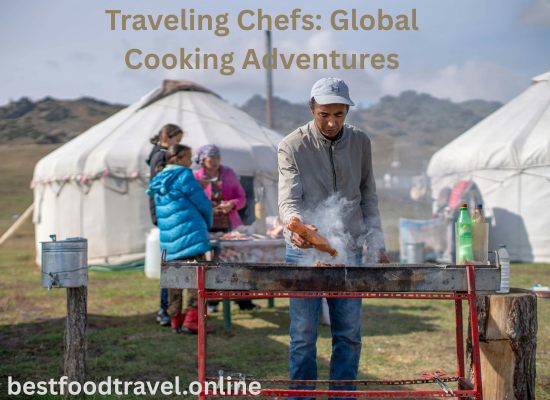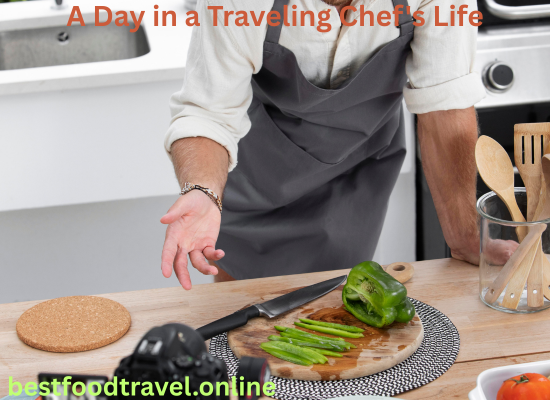I still remember meeting Marco, a traveling chef from Spain, who told me his story while chopping vegetables at lightning speed. “Cooking in just one kitchen for your whole life?” he laughed. “That would be like only reading one book when there’s a whole library out there!” His sun-tanned face showed the miles he’d traveled, and his hands told stories of countless meals prepared across continents.

Traveling chefs like Marco are a special breed. They’re culinary nomads who pack their knife sets and embark on food journeys most of us only dream about. Let me take you into their world of spices, stories, and sizzling pans.
What Makes Someone a Traveling Chef?
My friend Tehreem worked in the same restaurant for 15 years before she quit to become a traveling chef. “I felt stuck,” she told me over coffee last summer. “I was cooking the same menu day after day, and I knew there was a whole world of flavors I was missing.”
Traveling chefs are cooks who choose movement over stability. Instead of working in the same kitchen year after year, they:
- Cook in different countries and kitchens
- Learn recipes directly from local experts
- Use ingredients most chefs only read about in books
- Share meals with people from all walks of life
Some work on cruise ships crossing oceans. Others find jobs as personal chefs for families who travel. Many simply save money, then travel from place to place, picking up cooking work or trading skills for food and lodging.
Why They Choose This Crazy Lifestyle
When I asked several traveling chefs why they chose this unpredictable path, their eyes lit up with similar stories:
Read more: “Top Food Travel Dinner Ideas: Tasty Meals for Your Adventure”
The Thrill of New Techniques
“In Thailand, I learned to balance five flavors in every dish,” said Ray, a chef from California who’s been traveling for seven years. “In France, I discovered 100 ways to cook an egg. No cooking school could have taught me what I’ve learned on the road.”
These chefs don’t just read about food traditions – they live them. They learn to make hand-pulled noodles in China by working alongside noodle masters who’ve been perfecting their craft for decades.
The Magic of Fresh, Local Ingredients
“Once you’ve cooked with tomatoes picked that morning in Sicily,” my neighbor’s daughter Sofia told me after her year as a traveling chef, “supermarket tomatoes just make you sad.”
Traveling chefs experience ingredients at their source – olives straight from ancient groves, spices from the markets where they’ve been sold for centuries, fish still flipping from the morning catch.
The Stories Behind Every Dish
Every dish has a story, and traveling chefs collect these stories like treasures. They learn why certain foods are sacred in some cultures, how war and peace shaped regional cuisines, and how grandmothers pass down recipes that never appear in cookbooks.
Read more: Exploring the World with Food and Adventure
Personal Growth Beyond Cooking
“I went seeking new recipes,” said Tomás, a Brazilian chef I met at a food festival. “But I found myself instead.”
The challenges of navigating foreign markets, communicating with limited language skills, and adapting to new customs build resilience that goes beyond cooking skills.
Real-Life Traveling Chef Stories
I’ve collected stories from several traveling chefs over the years. Here are some that stuck with me:
Elena left her accounting job to travel and cook. In Morocco, she got stranded when her wallet was stolen. A local family took her in and taught her to make traditional tagine during the three weeks she stayed with them. Now she runs Morocco cooking tours.
Jamal worked his way through Southeast Asia by offering to cook dinner for hostels in exchange for free stays. “I started with five recipes,” he laughed. “By the end of the year, I had hundreds—and friends in every country.”
Sarah specialized in French cuisine before traveling. “In Japan, I had to unlearn everything,” she told me. “Their approach to ingredients is completely different. It changed how I see food forever.”
A Day in a Traveling Chef’s Life

No two days are the same for a traveling chef, but most follow patterns I’ve observed from the ones I’ve interviewed:
Dawn often finds them in local markets. Not the tourist markets, but the real ones where grandmothers haggle over the freshest produce. They touch, smell, and sometimes taste unfamiliar ingredients, asking questions with hand gestures when words fail.
Midday might include cooking lessons. In someone’s home kitchen, they learn family recipes passed down through generations. Or maybe they’re volunteering in a busy restaurant kitchen, absorbing techniques through observation and practice.
Evenings often involve cooking for others – perhaps hosting a pop-up dinner, cooking for their host family, or preparing a staff meal in a restaurant that’s letting them hang around to learn.
Late nights are for recording discoveries in worn notebooks – sketching unusual ingredients, writing down recipes before they’re forgotten, planning tomorrow’s food adventures.
The Hard Parts Nobody Talks About
When I asked traveling chefs about challenges, they shared the less glamorous realities:
Getting Lost in Translation
“I once used what I thought was salt in a dessert because I couldn’t read the label,” admitted Jason, laughing at the memory. “It was fish powder. The guests were too polite to say anything, but nobody finished their cake.”
Kitchen communication is hard enough in your native language. Now imagine trying to learn knife skills when you don’t understand the warnings or instructions.
Read more: “Journey Munch: Savoring the World, One Bite at a Time”
Making Do With Whatever’s Available
Many traveling chefs told me stories of promised equipment that didn’t exist or ingredients that couldn’t be found. “You learn to adapt,” shrugged Leila. “No food processor? Find a mortar and pestle. No oven? Figure out a stovetop method.”
Kitchen Culture Shock
“In some countries, kitchens are strictly hierarchical. In others, everyone jumps in to help with everything,” explained Carlos. “You can unintentionally offend people just by following what would be normal behavior back home.”
The Loneliness of the Road
Behind the exciting Instagram posts are lonely nights in strange places. “Sometimes I just want my own bed and my mom’s cooking,” admitted Zoe, who’s been traveling for three years. “But then I learn something amazing the next day, and it’s all worth it again.”
How to Join This Traveling Tribe
During my research, I asked every traveling chef: “How would someone start doing what you do?” Here’s their collective wisdom:
- Master the basics first – Learn fundamental techniques before hitting the road
- Save aggressively – Many start with several months of living expenses saved up
- Travel light but keep your knives – Most traveling chefs have one good knife roll they guard with their lives
- Build an online presence – A portfolio website or active social media helps find opportunities
- Network before you go – Reach out to chefs and food people in destinations before arriving
- Consider formal programs – Some culinary schools have exchange programs that can give you a structured start
- Be humble – “The moment you think you know everything is when you stop learning,” as Marco told me
Food Destinations That Changed Chefs’ Lives
When I asked where their most transformative experiences happened, these destinations came up repeatedly:
Oaxaca, Mexico impressed chefs with its complex moles and pre-Hispanic cooking techniques. “I thought I understood chili peppers before Oaxaca,” said one chef. “I was a complete beginner.”
Southern India changed how many chefs think about vegetarian cooking. The elaborate spice combinations and regional differences across a relatively small area left many in awe.
Bologna, Italy taught pasta-making to many traveling chefs. “Watching 80-year-old nonnas roll pasta thinner than paper with just a wooden pin will make you question everything you thought you knew,” said Elena.
Penang, Malaysia came up repeatedly for its unique fusion of Malay, Chinese, and Indian influences. “It’s like three culinary worlds collided and created something greater than the sum of its parts,” raved Jamal.
How Modern Traveling Chefs Share Their Journeys
Today’s traveling chefs don’t just collect experiences—they share them:
Some write deeply personal food blogs, documenting not just recipes but the stories and people behind them.
Others host pop-up dinners when they return home, recreating dishes and sharing tales from their travels.
A few have turned travel journals into beautiful cookbooks that are as much travel memoirs as recipe collections.
Many lead culinary tours, taking food lovers back to the places and people that changed their own cooking forever.
Is This Life For You?
After talking with dozens of traveling chefs over the years, I’ve noticed common traits among those who thrive:
They’re curious above all else. Every unfamiliar ingredient is an opportunity, not a challenge.
They roll with the punches. When plans fall through (and they will), they find new paths forward.
They’re respectful students. They approach unfamiliar food cultures with humility, eager to learn rather than show off what they already know.
They’re natural connectors. Even with language barriers, they build relationships through the universal language of food.
Read more: “Cat Wet Food Pouches: A 2025 Guide for Happy Kitties”
Conclusion
Something interesting happens when traveling chefs finally return home. Their cooking is transformed. Dishes they’ve made for years take on new dimensions, informed by techniques learned in distant kitchens.
“I make my grandmother’s tomato sauce differently now,” Sofia told me. “She pretends to be offended, but then asks for my version of her recipe.”
These culinary nomads bring back more than recipes. They carry stories, techniques, and perspectives that enrich our understanding of food and its place in human culture.
As Marco said while sliding a perfectly crisp paella onto the table, “The best souvenir from traveling isn’t spices or cooking tools. It’s the way you never see food the same way again.”
FAQS
How do traveling chefs make money?
Most patch together income from various sources. Some save up before traveling, others teach cooking classes, work temporary restaurant gigs, cater private events, or create content about their experiences.
Do you need to go to cooking school first?
Many traveling chefs I’ve met have formal training, but others learned through restaurant experience. What matters most is solid fundamental skills and the right attitude.
What’s the biggest misconception about this lifestyle?
“That it’s all glamorous,” laughed Elena. “For every beautiful plate of food in an amazing location, there are ten sweaty, frustrated hours of getting lost, miscommunications, and kitchen disasters you never see on Instagram.”

What’s up Sania, your article is great.
– Merlin AI – Your Universal Assistant for Work, Study, and Creativity! ???
– Merlin is a powerful AI aggregator combining ChatGPT, Claude, DeepSeek, Gemini, Llama, and other top AI models. Now available without VPN for seamless access worldwide!
– What Can Merlin AI Do?
Text Generation – Create articles, posts, resumes, and marketing materials in seconds!
Code Writing – From simple scripts to complex algorithms, bug fixing, and optimization.
Image Generation – Design unique artwork, logos, and creative concepts.
Data Analysis – Structure information, make predictions, and process large datasets.
Translations & Text Processing – Instant translation into dozens of languages, SEO-friendly text creation.
AI Bot Creation – Develop personalized assistants that handle specific tasks.
Browser Integration – Instantly analyze web pages and generate content directly in your browser!
https://www.getmerlin.in/chat?ref=nwuxm2n
– Why Choose Merlin?
All top AI models in one service – ChatGPT, Claude, Gemini, and more.
No VPN required – Work freely without restrictions or complicated setups.
Affordable access – A fraction of the cost compared to individual AI subscriptions!
Convenient mobile apps – Available on Android and iOS in Russian stores.
Free trial – Message us and try Merlin AI for free!
Try Merlin AI now! Click here and unlock new possibilities with artificial intelligence! ??
Sign up and get free generations: https://www.getmerlin.in/chat?ref=nwuxm2n
#MerlinAI #ArtificialIntelligence #AI #ChatGPT #Automation
– Merlin AI – Твой универсальный помощник для работы, учебы и творчества! ???
– Merlin – это мощный агрегатор нейросетей, объединяющий ChatGPT, Claude, DeepSeek, Gemini, Llama и другие топовые AI. Теперь доступ без VPN прямо из России! ????
– Что умеет Merlin AI?
Генерация текстов – статьи, посты, резюме, рекламные материалы за секунды!
Написание кода – от простых скриптов до сложных алгоритмов, исправление багов и оптимизация.
Генерация изображений – создавай уникальные арты, логотипы, концепты.
Анализ данных – структурируй информацию, делай прогнозы и анализируй большие объемы данных.
Переводы и работа с текстами – мгновенный перевод на десятки языков, создание SEO-текстов.
Создание AI-ботов – персонализированные ассистенты, выполняющие нужные задачи.
Интеграция с браузером – моментальный анализ веб-страниц и генерация контента прямо в браузере!
– Почему выбирают Merlin?
Все топовые нейросети в одном сервисе – ChatGPT, Claude, Gemini и другие.
Без VPN – работай без ограничений и сложных настроек.
Доступ в 10 раз дешевле – подписка от 2400 ?/мес вместо сотен долларов!
Удобные приложения – доступно на Android и iOS в российских магазинах.
Бесплатный тест – напиши нам и попробуй Merlin AI бесплатно!
Попробуй Merlin AI прямо сейчас! https://www.getmerlin.in/chat?ref=nwuxm2n и открой новые возможности с искусственным интеллектом! ??
Регистрация и бесплатные генерации: https://www.getmerlin.in/chat?ref=nwuxm2n
Если у вас сложности с оплатой из РФ, то пишите: https://roboex.tilda.ws/
#MerlinAI #ИскусственныйИнтеллект #Нейросети #ChatGPT #Автоматизация
Thanks a lot for sharing the link